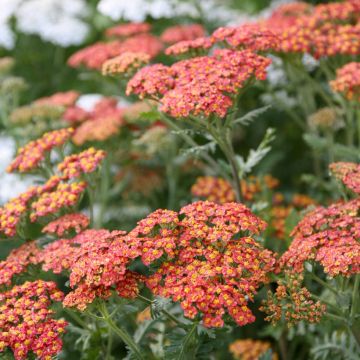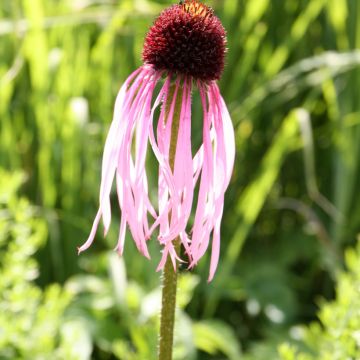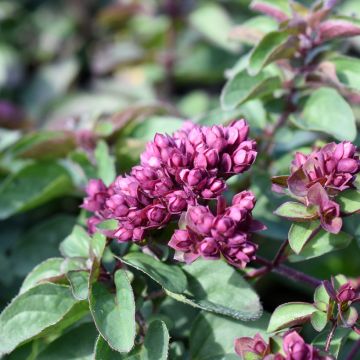

Achillea millefolium Cassis


Achillea millefolium Cassis


Achillea millefolium Cassis
Achillea millefolium Cassis
Achillea millefolium Cassis
Common Yarrow, Milfoil, Thousand-leaf, Nosebleed plant
Planted a year ago. Very easy plant to grow in dry soil during the summer and in the sun. Beautiful flower colour.
NL, 10/10/2024
Special offer!
Receive a €20 voucher for any order over €90 (excluding delivery costs, credit notes, and plastic-free options)!
1- Add your favorite plants to your cart.
2- Once you have reached €90, confirm your order (you can even choose the delivery date!).
3- As soon as your order is shipped, you will receive an email containing your voucher code, valid for 3 months (90 days).
Your voucher is unique and can only be used once, for any order with a minimum value of €20, excluding delivery costs.
Can be combined with other current offers, non-divisible and non-refundable.
Home or relay delivery (depending on size and destination)
Schedule delivery date,
and select date in basket
This plant carries a 12 months recovery warranty
More information
We guarantee the quality of our plants for a full growing cycle, and will replace at our expense any plant that fails to recover under normal climatic and planting conditions.
Would this plant suit my garden?
Set up your Plantfit profile →
Description
Achillea millefolium Cassis is a variety of yarrow that stands out for its long and abundant cherry red flowering that turns pink. It is a perennial plant appreciated for its dense and vigorous vegetation that covers the soil, as well as its resistance to heat and drought. As ornamental as it is easy to care for, it is perfect for quickly filling slopes, dressing borders, or creating beautiful country bouquets. Exuberant and undemanding, this garden regular brings a nostalgic charm to unpretentious flowerbeds.
The Achillea millefolium Cassis is a beautiful descendant of the yarrow, a perennial herbaceous plant from the Asteraceae family native to Europe and Asia Minor. It develops from spring onwards, a compact and upright tuft that spreads through stolons, allowing it to cover large areas. 'Cassis' will reach approximately 60 cm (24in) in height when in bloom, 10 to 20 cm (4 to 8in) for the foliage. It spreads over 50 cm (20in) and more. The remarkably long flowering period extends from June to September if the soil remains slightly moist during the hottest part of summer. It takes the form of flower heads called corymbs, flattened and rounded, approximately 7 cm (3in) in diameter. The flowers have yellow tubular florets in the centre and colourful ligulate florets on the edges. The flower head is initially bright red-pink and then fades to pink as it withers. The stem is channelled and villous, and the aromatic foliage is finely divided into feathery strips and has a dark grey-green, matte colour.
This hardy and undemanding perennial will integrate well in rock gardens, on top of a wall, along flowerbeds and pathways, or on a slope where it will help prevent erosion. With its stolons, it can be used as a ground cover over large areas. It can withstand the root competition from trees and can be planted at the base of a sunny hedge. Easy to grow and water-frugal, it can be paired with lovely ornamental grasses such as Pennisetum setaceum Rubrum and Stipa tenuifolia, ornamental garlic Allium sphaerocephalon or even 'Caradonna' sage in a small countryside scene bursting with colour.
Yarrow is a medicinal herb that has healing properties. It can also stop bleeding, reduce muscle spasms, and strengthen the body. You can enjoy its young shoots in salads or omelettes.
Report an error about the product description
Achillea millefolium Cassis in pictures




Flowering
Foliage
Plant habit
Botanical data
Achillea
millefolium
Cassis
Asteraceae
Common Yarrow, Milfoil, Thousand-leaf, Nosebleed plant
Cultivar or hybrid
Other Achillea
View all →Planting and care
The Achillea millefolium 'Cassis' is a plant that can be grown in pots all year round. It is best to plant around 5 feet per square metre in soil that is well-worked and has proper drainage. This plant can grow in any type of soil, be it dry or moist, even limestone, and it can even adapt to clay soils, as long as they are healthy and well amended. Although it can tolerate partial shade, it prefers full sun for more colourful flowers. To encourage new growth in spring, remove faded flowers and prune all vegetation at the end of the season. Divide the shrub in spring.
Planting period
Intended location
Care
-
, onOrder confirmed
Reply from on Promesse de fleurs
Similar products
Haven't found what you were looking for?
Hardiness is the lowest winter temperature a plant can endure without suffering serious damage or even dying. However, hardiness is affected by location (a sheltered area, such as a patio), protection (winter cover) and soil type (hardiness is improved by well-drained soil).

Photo Sharing Terms & Conditions
In order to encourage gardeners to interact and share their experiences, Promesse de fleurs offers various media enabling content to be uploaded onto its Site - in particular via the ‘Photo sharing’ module.
The User agrees to refrain from:
- Posting any content that is illegal, prejudicial, insulting, racist, inciteful to hatred, revisionist, contrary to public decency, that infringes on privacy or on the privacy rights of third parties, in particular the publicity rights of persons and goods, intellectual property rights, or the right to privacy.
- Submitting content on behalf of a third party;
- Impersonate the identity of a third party and/or publish any personal information about a third party;
In general, the User undertakes to refrain from any unethical behaviour.
All Content (in particular text, comments, files, images, photos, videos, creative works, etc.), which may be subject to property or intellectual property rights, image or other private rights, shall remain the property of the User, subject to the limited rights granted by the terms of the licence granted by Promesse de fleurs as stated below. Users are at liberty to publish or not to publish such Content on the Site, notably via the ‘Photo Sharing’ facility, and accept that this Content shall be made public and freely accessible, notably on the Internet.
Users further acknowledge, undertake to have ,and guarantee that they hold all necessary rights and permissions to publish such material on the Site, in particular with regard to the legislation in force pertaining to any privacy, property, intellectual property, image, or contractual rights, or rights of any other nature. By publishing such Content on the Site, Users acknowledge accepting full liability as publishers of the Content within the meaning of the law, and grant Promesse de fleurs, free of charge, an inclusive, worldwide licence for the said Content for the entire duration of its publication, including all reproduction, representation, up/downloading, displaying, performing, transmission, and storage rights.
Users also grant permission for their name to be linked to the Content and accept that this link may not always be made available.
By engaging in posting material, Users consent to their Content becoming automatically accessible on the Internet, in particular on other sites and/or blogs and/or web pages of the Promesse de fleurs site, including in particular social pages and the Promesse de fleurs catalogue.
Users may secure the removal of entrusted content free of charge by issuing a simple request via our contact form.
The flowering period indicated on our website applies to countries and regions located in USDA zone 8 (France, the United Kingdom, Ireland, the Netherlands, etc.)
It will vary according to where you live:
- In zones 9 to 10 (Italy, Spain, Greece, etc.), flowering will occur about 2 to 4 weeks earlier.
- In zones 6 to 7 (Germany, Poland, Slovenia, and lower mountainous regions), flowering will be delayed by 2 to 3 weeks.
- In zone 5 (Central Europe, Scandinavia), blooming will be delayed by 3 to 5 weeks.
In temperate climates, pruning of spring-flowering shrubs (forsythia, spireas, etc.) should be done just after flowering.
Pruning of summer-flowering shrubs (Indian Lilac, Perovskia, etc.) can be done in winter or spring.
In cold regions as well as with frost-sensitive plants, avoid pruning too early when severe frosts may still occur.
The planting period indicated on our website applies to countries and regions located in USDA zone 8 (France, United Kingdom, Ireland, Netherlands).
It will vary according to where you live:
- In Mediterranean zones (Marseille, Madrid, Milan, etc.), autumn and winter are the best planting periods.
- In continental zones (Strasbourg, Munich, Vienna, etc.), delay planting by 2 to 3 weeks in spring and bring it forward by 2 to 4 weeks in autumn.
- In mountainous regions (the Alps, Pyrenees, Carpathians, etc.), it is best to plant in late spring (May-June) or late summer (August-September).
The harvesting period indicated on our website applies to countries and regions in USDA zone 8 (France, England, Ireland, the Netherlands).
In colder areas (Scandinavia, Poland, Austria...) fruit and vegetable harvests are likely to be delayed by 3-4 weeks.
In warmer areas (Italy, Spain, Greece, etc.), harvesting will probably take place earlier, depending on weather conditions.
The sowing periods indicated on our website apply to countries and regions within USDA Zone 8 (France, UK, Ireland, Netherlands).
In colder areas (Scandinavia, Poland, Austria...), delay any outdoor sowing by 3-4 weeks, or sow under glass.
In warmer climes (Italy, Spain, Greece, etc.), bring outdoor sowing forward by a few weeks.



















































